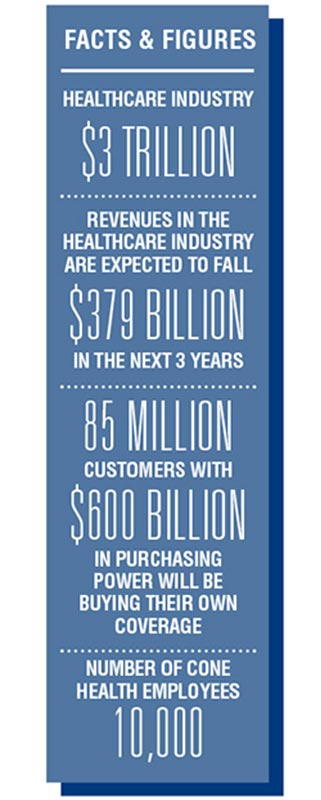Survival at the Tipping Point
How do you move forward when the road ahead is uncertain? For one North Carolina healthcare provider, it was focusing on what they do, not what they earn.
When the young son of two nurses at North Carolina-based Cone Health suffered a serious head injury in a skateboard accident earlier this year, the company’s staffers went out of their way to make sure the boy got the best care possible, even volunteering their time to drive the boy to an out-of-state rehabilitation center every weekend. Cone Health CEO Tim Rice used that story, told in a 12-minute video, to open a corporate board retreat this past fall.
“When the video ended — and you better have had a tissue handy at that point — I told the board that our people, and the kind of care they give, is why we’re here,” he says. “And we need to remember that as we begin the discussions about our future.”
Those discussions were not easy ones. Cone is just one of the many U.S. healthcare providers dealing with an unprecedented upheaval in their nearly $3 trillion industry. The federal Affordable Care Act, budget cuts at the state and local level, and a soft economy has prompted a wave of industry consolidation and a cascade in revenues. Among the biggest hits to revenue is an overhaul of Medicare.
Revenues are expected to fall by $379 billion nationwide in the next eight years, a time that most analysts say will be marked by deflation in most healthcare costs. As a result, healthcare companies are merging at a heated pace, not just to expand market share, but to slash costs in an effort to make up for the expected revenue loss. One healthcare research firm found that industry mergers have more than doubled from 2009 to 2012, and another reports that one-fifth of all the nation’s 5,000 hospitals are likely to seek mergers in the next few years. Meanwhile, the industry is also shifting its focus to a more proactive model of patient care — one focused on preventing illness and injury.
Taken together, all of that change could make any healthcare executive feel a bit ill. How do you lead when your entire world is being disrupted, when your whole industry is in the middle of a massive transformation? For Cone Health’s leaders, there are a few key ways they’re trying to do just that.
NO. 1 //
IN TOUGH TIMES, TAKE BETTER CARE OF YOUR CUSTOMERS AND THE BOTTOM LINE WILL TAKE CARE OF ITSELF
Four years ago, Cone executives looked over their profitable bottom line and their years of solid revenue growth and decided that those numbers weren’t sufficient. The company’s leadership felt Cone Health needed a new direction.
“At that time we were producing pretty good margins,” Rice says, “and the board was saying ‘What are you worrying about?’ But we saw a freight train coming our way. We believed we’d be taking in $125 million less per year than we had been taking in if we didn’t do something to get in front of changes in the marketplace.”
So Cone Health embarked on a total cultural transformation. The goal: Put patients and providers first and compete on performance — on how well patients do under their care — on a national basis.
“The decision by the Cone leadership to invest in ensuring it has the right culture to provide exceptional care while adapting and innovating flew in the face of common sense,” says Shideh Sedgh Bina, Insigniam co-founding partner. “Common sense says that when facing looming shortfalls you focus all of your attention on efficiencies and cost-cutting. Yes, the Cone leaders had to make some tough fiscal decisions, and they did that while reinventing the very core of their culture. Now that takes guts — and wisdom.”
Today, the entire healthcare industry is steering in that same direction. Doctors, hospitals, and pharmacists are all seeing their financial rewards tied to making their patients better, not just providing treatment.
And consumers of healthcare are about to become better able to comparison shop among the providers who give the best care to their patients. According to a study published in 2013 by the Healthcare Innovation Center at Oliver Wyman, by next year, some 85 million consumers with $600 billion in purchasing power may be shopping for their own healthcare, and many of them “will be making their own decisions about coverage for the first time.”
That means hospitals will have to compete not with the care provider down the street or across the state, but with providers across the country. Walmart is already making that happen for its workers. It provides travel expenses to some workers who are willing to seek out top care providers nationally.
So how does Cone compete with providers in, say, California? Through a key core principle. The company’s top goal, set during its cultural transformation, is not to boost profits. It is, simply, to rank among the top decile of all hospital organizations nationwide in terms of what is known as Triple Aim Performance: patient experience, quality of care, and cost management. As a result of that effort to be in the top decile in Triple Aim, the company has dramatically increased patient safety, employee engagement, employee retention, and has boosted its scores in key areas of patient satisfaction by a rate that’s six times better than the average hospital nationwide. From there, they hope, that profits and growth, even in the turbulent future, will follow.
“This is a business, and financial results matter,” Rice says. “But providing top care is still the key context for gauging everything we do. And that has been really embraced by our clinicians. Tell me what surgeon goes into surgery in the morning and says, ‘I’d like to do an average surgery’?”
NO. 2 //
HONESTY IS THE BEST POLICY, OR TREAT EMPLOYEES LIKE GROWNUPS
 After decades of solid revenue and profit growth, this year Cone has struggled just to break even, which is why Rice’s board retreat discussions were not easy. Cuts and changes to Medicare outlay at the federal and state level cost the company $30 million just this year. As a result, Cone laid off 150 people and left another 150 open positions vacant. Those were the first layoffs in the company’s history.
After decades of solid revenue and profit growth, this year Cone has struggled just to break even, which is why Rice’s board retreat discussions were not easy. Cuts and changes to Medicare outlay at the federal and state level cost the company $30 million just this year. As a result, Cone laid off 150 people and left another 150 open positions vacant. Those were the first layoffs in the company’s history.
So how did the executives spin that news to their employees? They didn’t spin it at all. They just told them.
“Our employees are smart people,” Rice says. “And we treat them that way. We all feel the pain of the layoffs. But if we can tell people the ‘Why’ behind any decision we’ve made, they’ll understand it. Sure, there have been some people sniping. And with more than 10,000 employees, you’re going to have that. By and large, though, people have accepted what we’re doing because we’ve tried hard to be transparent and over-communicate the ‘why’ behind our decisions.”
That “over-communication” is one result of the company’s cultural transformation. “We’ve established an increased level of trust and an increased level of communication across the organization that is key in times like these,” says Terry Akin, Cone’s president and chief operating officer.
“The core of the new Cone is a bold and inspiring future — the opportunity to transform healthcare itself in service of a healthier community,” says Jen Zimmer, a partner at Insigniam who worked with Cone on its transformation. “When the enterprise is mobilized in service of something bigger than its own survival and the leaders lead in an authentic manner almost anything can be said and heard.”
NO. 3 //
WHEN THE INDUSTRY IS STRUGGLING, DON’T FOCUS TOO MUCH ON THE PRESENT — THE FUTURE STILL MATTERS.
Cone executives say they are pushing innovation and risk-taking now, even though the industry is in a period of uncertainty. Or, perhaps, because the industry is in a period of uncertainty.
“We have immediate financial issues to deal with,” Rice says. “And we will deal with those. But our focus has to be on the future, because this business, a year from now, won’t look like it does today. A lot of things we think of as providers may be very different in the very near future. We may not need to do near as many amputations because we’re controlling diabetes better now. We may not need near as many beds in the ICU because more patients are sent home to use home monitoring equipment now. We need to start planning out the breakthroughs that can happen in the industry and planning for what that’s going to change in terms of what a hospital looks like.
“The message we’re communicating to our board, to our leadership team, and to our people is that the tipping point for our industry is no longer coming. We’re at the tipping point. And we have to stay out in front of the changes that are coming.”
Akin says that’s why the company has been combining forces with other regional healthcare providers in recent years, including 2013, and has been tasking leaders at all levels of the organization to find ways to simultaneously cut costs and improve patient outcomes.
“We have wanted to avoid being in reactive mode,” he says. “We want to define and shape our future rather than have it shaped for us.”
NO. 4 //
REMEMBER, AND REMIND YOURSELF OFTEN OF, THE CORE MISSION.
Cone begins every executive meeting with a patient story — the same kind of story it told at the start of this fall’s board retreat. The reason: to remind leaders that their business exists for one reason, to care for patients.
“In times of stress, and we’re all going through the financial stresses in this industry right now, the numbers can be a huge distraction from the reasons we’re here,” Rice says. “But for our patients and our people, we can’t let that happen.”



